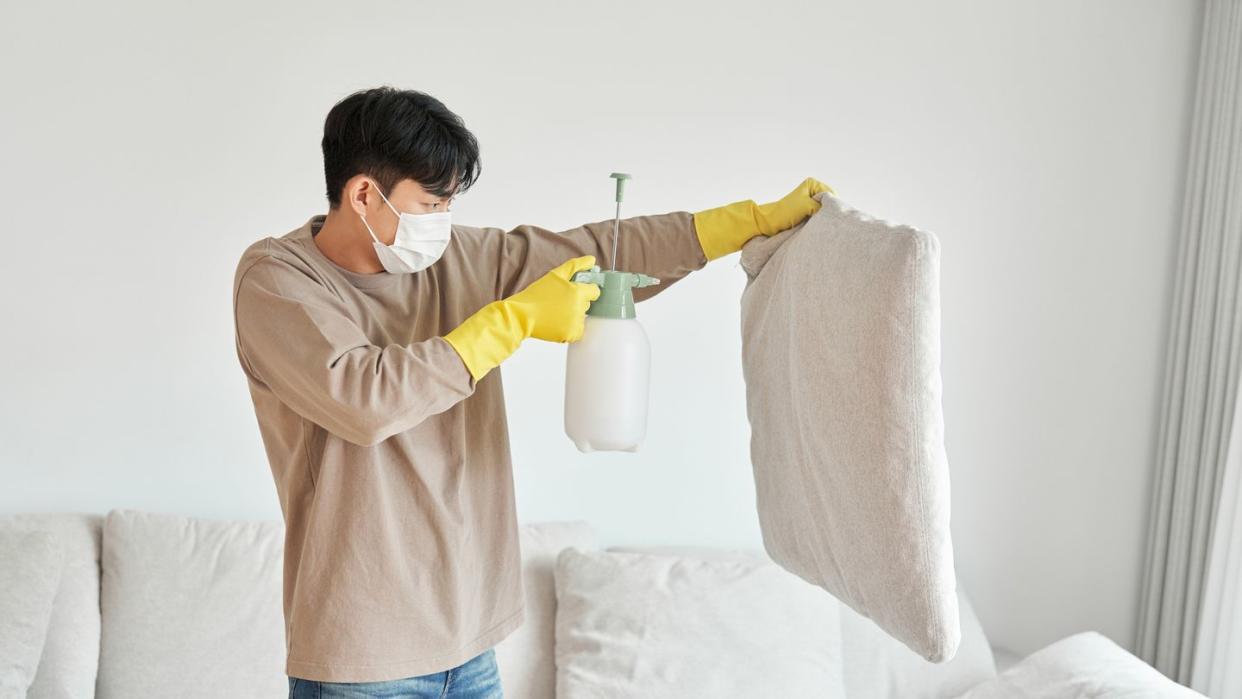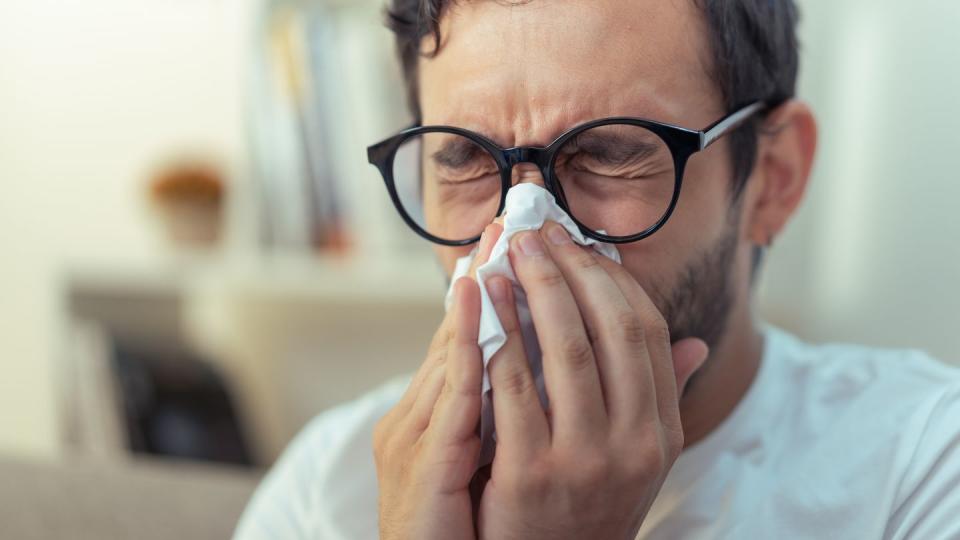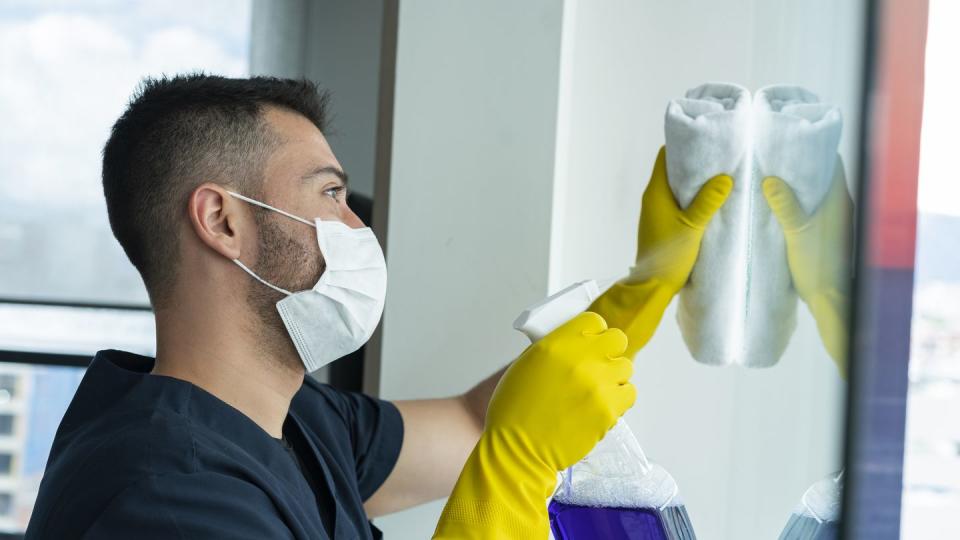The Main Symptoms of Mold Exposure

LETS FACE IT—unless you were born with the clean and tidy gene, you're probably not deep cleaning as much as you should be. No judgement here—whipping out the mop and bucket can feel like a daunting task. But once those small little black spots start popping up on the corners of your bathroom tile, you know it's time to break out the bleach. Those small mold spores could be causing you some agitating symptoms.
The symptoms of mold exposure look eerily similar to those that come with seasonal allergies. Are they treated the same? And, how dangerous is mold exposure, really? Experts tell all on mold exposure symptoms, below.
What Is Mold?
Mold is a common type of fungus that grows in wet, dark places. There are hundreds of species, but the most common that grow indoors are aspergillus, penicillium, alternaria, and cladosporidium. They grow in dark, damp places, such as areas with water damage or high humidity, like your shower or kitchen, says Lauren M. Zajac, M.D., a pediatrician, public health and general preventative medicine practitioner, and associate professor in the Department of Environmental Medicine and Public Health and the Department of Pediatrics at the Icahn School of Medicine at Mount Sinai.
What Are the Common Symptoms of Mold Exposure?
Significant exposure to this fungus can cause allergy-like symptoms.
"Breathing in mold spores can lead to allergies/hay fever in people who are sensitized to mold (who are diagnosed with a mold allergy through allergy testing)," says Zajac. Symptoms typically include:
Itchy, red eyes
Sneezing
Congestion
Runny nose
Coughing
Wheezing
Shortness of breath
Eye irritation
Skin rash
Research studies have also shown that these symptoms can show up even in those without allergies, she says.
Though not very common, more severe reactions can occur. This happens especially "among workers if they are exposed to large amounts of molds in occupational settings, such as farmers working around moldy hay. Severe reactions may include fever and shortness of breath," says Lorna Thorpe, Ph.D., professor and director of the Division of Epidemiology in the Department of Population Health at NYU Langone Health.
Severe mold exposure has also been linked to infections in people with compromised immune systems, or hypersensitive reactions in people with underlying lung disease.

What Does Mold Exposure Treatment Look Like?
If the symptoms are mild, "treatment is similar to that of other common allergies. Over-the-counter nasal corticosteroid sprays and oral antihistamines are the mainstay of management," says Christopher Gold, D.O., assistant professor of internal medicine at Mount Sinai Doctors Ansonia. "Avoiding exposure and removing the allergen, if found, can help alleviate symptoms as well."
If your symptoms are getting the best of you, you'll want to visit your doctor or local urgent care to get some help. Current testing measures are not super specific, says Gold. You may receive some basic allergy testing via skin pricks or antibody blood level tests, but these tests cannot determine the length or intensity of exposure, nor can it identify the type of mold you've been exposed to.
"The mainstay of treatment is removing the mold growth from the indoor environment, while also implementing healthy indoor air strategies such as ventilation, dust control, fixing water leaks, and reducing common air pollutants in the home (smoke, harsh cleaning chemicals, candles, etc)," Zajac says.
The Environmental Protection Agency suggests reducing humidity using exhaust fans, opening windows, or increasing the indoor air temperature. Scrub the mold off with detergent and water, and dry the area completely. It's important to note that even dead mold can cause allergic reactions in people, so you will need to remove the mold, not just kill it.
What Does Mold Exposure Put You at Risk For?
People react differently to mold depending on their allergies and sensitivity levels. Some may see symptoms right after exposure while others don't get any symptoms at all. There's no known minimum level of exposure (amount or duration) that is necessary to produce health effects, Zajac says.
While there are no known risks of long-term exposure, studies have found that exposure in children can increase the risk of developing asthma. Excessive exposure can also "cause hypersensitivity pneumonitis (allergic reaction causing inflammation of the lungs), though this is more commonly seen from workplace exposures such as agriculture and farming than from home exposure," Gold says. "Invasive fungal sinus infections can be more serious and potentially lethal, but again are uncommon and generally only occur in those with diabetes or immunocompromising conditions."
Even more rare: certain molds can produce mycotoxins, which can cause pulmonary hemorrhage (bleeding into the lungs) and memory loss. Specific mycotoxins called aflatoxins can be found on agricultural crops and can increase the risk of liver cancer. "It is unclear exactly how quickly you can develop these problems, but unless you are exposed to high amounts of mold over a longer period of time, or have serious underlying conditions, your risk is very low," Gold says.

How to Clean Up Mold
"The quality of the air we breathe, whether indoors or outdoors, can impact our health and well-being. Indoor air quality in particular is influenced by a number of factors including the ventilation, maintenance of the building, water and moisture control, and the products used inside the building," says Zajac.
If mold has started growing in your carpets, insulations, ceiling tiles, or drywall, you may need to consult with a contractor to discuss removal and replacement.
You can use any kind of household cleaner to disinfect the area, including regular soap or dish detergent. You can also use bleach, but beware to not mix bleach with other household cleaners. Also open windows and doors to provide ventilation prior to cleaning, and wear non-porous gloves and eye protection.
You Might Also Like

